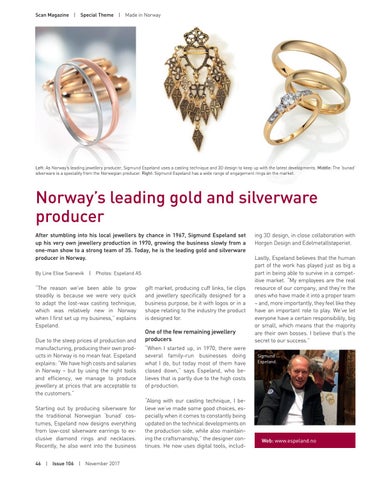Scan Magazine | Special Theme | Made in Norway
Left: As Norway’s leading jewellery producer, Sigmund Espeland uses a casting technique and 3D design to keep up with the latest developments. Middle: The ‘bunad’ silverware is a speciality from the Norwegian producer. Right: Sigmund Espeland has a wide range of engagement rings on the market.
Norway’s leading gold and silverware producer After stumbling into his local jewellers by chance in 1967, Sigmund Espeland set up his very own jewellery production in 1970, growing the business slowly from a one-man show to a strong team of 35. Today, he is the leading gold and silverware producer in Norway. By Line Elise Svanevik | Photos: Espeland AS
“The reason we’ve been able to grow steadily is because we were very quick to adapt the lost-wax casting technique, which was relatively new in Norway when I first set up my business,” explains Espeland. Due to the steep prices of production and manufacturing, producing their own products in Norway is no mean feat. Espeland explains: “We have high costs and salaries in Norway – but by using the right tools and efficiency, we manage to produce jewellery at prices that are acceptable to the customers.” Starting out by producing silverware for the traditional Norwegian ‘bunad’ costumes, Espeland now designs everything from low-cost silverware earrings to exclusive diamond rings and necklaces. Recently, he also went into the business 46 | Issue 106 | November 2017
gift market, producing cuff links, tie clips and jewellery specifically designed for a business purpose, be it with logos or in a shape relating to the industry the product is designed for.
One of the few remaining jewellery producers “When I started up, in 1970, there were several family-run businesses doing what I do, but today most of them have closed down,” says Espeland, who believes that is partly due to the high costs of production. “Along with our casting technique, I believe we’ve made some good choices, especially when it comes to constantly being updated on the technical developments on the production side, while also maintaining the craftsmanship,” the designer continues. He now uses digital tools, includ-
ing 3D design, in close collaboration with Horgen Design and Edelmetallstøperiet. Lastly, Espeland believes that the human part of the work has played just as big a part in being able to survive in a competitive market. “My employees are the real resource of our company, and they’re the ones who have made it into a proper team – and, more importantly, they feel like they have an important role to play. We’ve let everyone have a certain responsibility, big or small, which means that the majority are their own bosses. I believe that’s the secret to our success.” Sigmund Espeland.
Web: www.espeland.no
